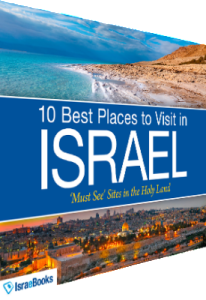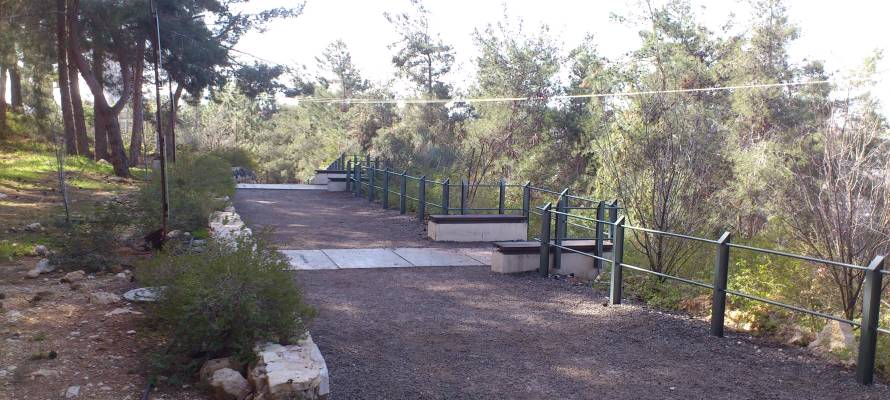A visit to Yad Vashem is emotionally charged, as is a visit to Mount Herzl cemetery, but somehow, the Connecting Path helps us channel our emotions in a hopeful direction.
A very meaningful way to conclude a visit to Yad Vashem, Israel’s official Holocaust memorial, is to walk through the Connecting Path that leads to Mount Herzl National Cemetery.
The Connecting Path, an initiative of Holocaust survivor Yehuda Szternfeld, starts with the liberation of the Nazi camps at the end of WWII in May 1945 and includes key aspects of the struggle to establish the State of Israel and fight the War of Independence.
The path features a remarkable view over Yad Vashem and signs posted every few meters, focusing on the main issues of the time: “illegal” immigration of Jews fleeing Europe to Palestine under the British Mandate, the pre-IDF (Israel Defense Forces) fighting units known as the Hagana, Etzel (or Irgun) and Lechi, and the Declaration of the State of Israel on May 14, 1948.
It’s important to remember that at the time of the declaration of the State, 90% of Jews in the Land of Israel had lost at least one family member in the Holocaust. To Irgun leader Menachem Begin and many others, therefore, it was a clear choice between returning to the death camps or establishing a Jewish state. This is also why Golda Meir was crying inconsolably when she signed the Declaration. She explained that she was crying for all those who should have been there, but were not.
The path was built by Israeli youth groups and opened in 2003. It ends with a very powerful “Last of Kin” memorial, also an initiative of Szternfeld, dedicated to the 433 soldiers killed fighting for the State of Israel who were also the last surviving members of their families from the Holocaust.
A visit to Yad Vashem is emotionally charged, as is a visit to Mount Herzl cemetery, but somehow, the Connecting Path helps us channel our emotions from in a hopeful direction.
Parallels to the Story of Purim
There are many remarkable parallels between this connecting path and the Book of Esther that we read on the recent Jewish holiday of Purim.
In the Book of Esther, the Jews are threatened with genocide by Haman (a descendant of the Biblical nemesis of the Jewish People – Agag, the King of Amalek). Through Esther’s willingness to risk her life to stand up for her people, Haman is executed, but the decree on the lives of the Jewish people cannot be revoked. King Achashverosh explains to Esther, “a document that was written in the name of the king and firmly sealed with the king’s signet ring cannot be recalled (Esther 8:8).” Instead of preventing an attack on the Jewish People, the king issues another decree, enabling the Jews to fight back.
This is an important difference between the Jews in the Holocaust and those in the Land of Israel. In both places, Jewish lives were threatened, but, for the most part, in the Holocaust, Jews were unable to defend themselves. While it could be seen as tragic for Holocaust survivors to be forced to fight for their lives immediately upon arrival in a new place, many survivors who fought in the War of Independence in 1948 were greatly comforted by their ability to finally fight back against an enemy of the Jewish people.
Our Modern-Day Heroes
Continuing the walk through Mount Herzl, you will see the graves of great early-Zionist leaders, such as Theodor Herzl, who almost prophetically declared in 1897 at the First World Zionist Congress, “Today I have established the Jewish State, and in 50 years everyone will see it.”
Herzl didn’t live to see the establishment of the State, but was reburied in Israel (according to his wishes) in 1949 at what was to become the new National Cemetery; the Mount of Olives and Mount Scopus were inaccessible due to Jordanian control of the area at the time.
Several prime ministers, presidents, and speakers of the knesset (Israeli parliament) and their spouses are buried in the National Leaders section, including Levi Eshkol, Yitzchak and Leah Rabin, and Golda Meir. There is a wonderful (sad, but powerful) route through all of Israeli history until today in the National Military Cemetery as well.
Many visitors stop by the graves of Hannah Senesh, who was captured and killed after going back to Nazi-occupied Europe to help the Jewish community there; HaLamed Heh, the 35 fighters who were ambushed while bringing supplies to the Etzion Bloc in January 1948; courageous heroes such as Eli Cohen, whose burial place is unknown; Michael Levin, an American lone soldier who died in the 2006 war with Hezbollah in Lebanon, and all of the great men and women who gave their lives to protect the Jewish People and the Land of Israel.
The exquisite cyclamen flowers thriving on the rocks on Mount Herzl deliver a profound message: Am Yisrael Chai. Despite it all, the Jewish People will survive – and bloom.
By: Leah Bowman
(The author, a licensed tour guide, leads inspiring tours throughout Israel, including child-friendly and bible tours. Check out her website and blog page.)

Free Ebook: 10 Best Places to Visit in Israel
The Land of Israel has provided the backdrop for some of the most important events in human history. From the Old City in Jerusalem to the Sea of Galilee, people from all over the globe visit the Holy Land each year to take in the breathtaking scenery and inspiration of Israel. Now you can experience this beauty for yourself from the comforts of home and maybe plan a trip of your own to Israel. Get the free, exclusive eBook from United with Israel: The 10 Best Places to Visit in Israel.
